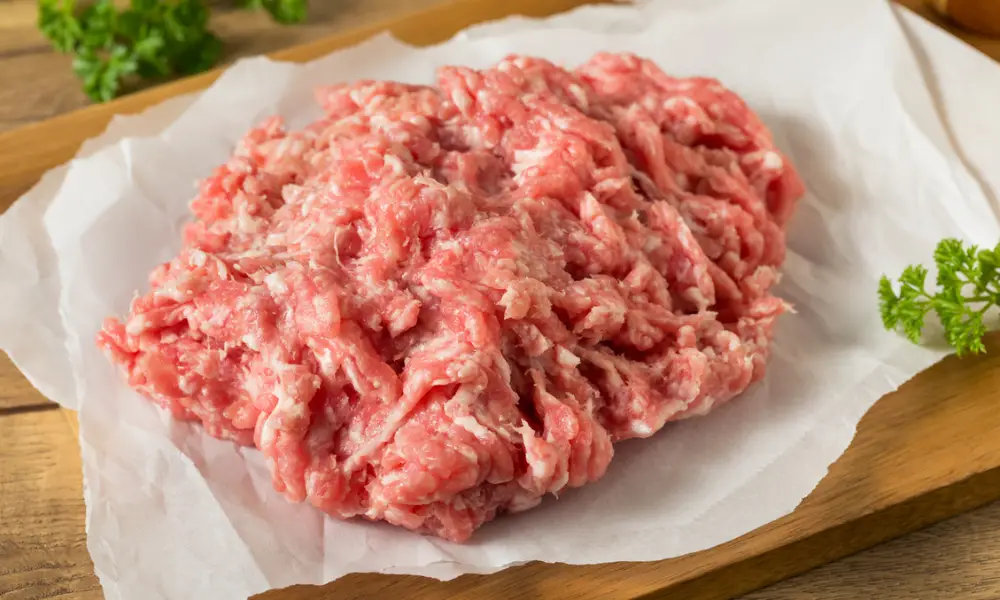Uncooked ground pork is usually best cooked and eaten within a day or two. But it can also be stored in the fridge for a few days, depending on the type of pork. It’s important to follow the expiration date on the package, and the meat should never be left out at room temperature for more than two hours. Whether you’re using it for a recipe or storing it later, you should keep in mind the risks of consuming sour ground pork.
Keeping your meat in the fridge for longer than this should be avoided, as it can get moldy and give off a foul smell. Bacteria can also grow on your food, and if you don’t dispose of it as quickly as possible, it can cause you to get sick. And when it comes to foodborne illnesses, it’s never a good idea to take chances.

What is Ground Pork?
Pork that has been ground or minced using a food processor or a meat grinder is referred to as ground pork. It is a flexible and practical variety of pig that works well in various recipes such as meatballs, meatloaf, sausages, and meat sauces.
The nutritional value of ground pork and its flavor, texture, and cooking behavior can all be impacted by its fat level. Various pig parts make ground pork, including the shoulder, belly, and leg. It can be purchased with various fat contents, including lean, regular, and extra fat.
The versatile component of ground pork can be used in savory and sweet meals and can be employed in a wide range of recipes. It can be added to spaghetti sauce, chili, or tacos, used as a filling for breakfast products like breakfast sausages, pig patties, or pork and egg breakfast burritos, or used as a filling for dumplings, wontons, or empanadas.
Ground pork should be handled and stored carefully to reduce the danger of food illness, just like any other raw meat. Use it within two to three days of purchase, keep it cold, and cook it to an internal temperature of at least 160F (71C).
How Long does Ground Pork Last in the Fridge?
The amount of time ground pork will last in the fridge depends on several things, including how fresh it was when it was ground and how carefully it was handled, packaged, and stored.
The following are some general principles:
- Freshly ground pork will be kept in the fridge for 1-2 days at or below 40°F (4°C).
- Commercially available ground pork will keep for a maximum of 2-3 days in the refrigerator at or below 40°F (4°C).
It’s crucial to remember that these are merely general recommendations, and it’s always better to err on the side of caution and reject meat if it has been sitting out for an excessive amount of time or if it appears or smells bad.
Ground pork’s shelf life can be increased, cross-contamination with other foods is prevented, and its quality and safety are maintained with proper handling, packaging, and storage. To remember when it has to be used, keep it tightly wrapped or in an airtight container, place it in the refrigerator’s coldest section, and mark the package with the date of purchase.
It’s important to keep in mind that the shelf life would be shorter if the pork were previously frozen and thawed; it should be eaten within 1-2 days of thawing. Additionally, to eliminate any potential germs, cook ground pork until it reaches a minimum internal temperature of 160F (71C).
How to Freeze Ground Pork?
You can greatly increase the shelf life of ground pork by freezing it, ensuring that you always have some on hand. Following are some recommendations for freezing ground pork: To correctly package ground pork, it must be firmly wrapped in plastic wrap, put in airtight containers, or stored in heavy-duty freezer bags with as little air as possible. This will prevent freezer burn and maintain the integrity of the meat.
Divide it into smaller chunks before freezing, making it simpler to thaw and cook if you only need to use a small bit of ground pork at a time.
To track how long the meat has been frozen and to ensure that it is used before it expires, label the package with the type of meat and the date it was frozen.
Place it in the freezer’s coldest section for storage: The bottom or rear of the freezer, where the temperature is most stable, is where you should put the ground pork to keep it cold.
Use it within a fair amount of time: Most ground pork can be frozen for up to 4 months, but it’s better to use it within 2-3 months for optimal quality.
When you’re ready to cook the ground pork, defrost it in the fridge or microwave; never let it get to room temperature.
When done correctly, freezing ground pork can be a handy method to always have some on hand. To reduce the danger of contracting a foodborne illness, always carefully handle, package, store, and defrost the pork.
What are the Different Ways of Thawing Frozen Ground Pork?
The following techniques are secure for defrosting frozen ground pork:
Thawing in a refrigerator is the safest way since it enables the pork to thaw gradually and at a stable temperature. Depending on the size of the box, place the ground pork in its original container in the refrigerator and let it thaw for 1-2 days.
Thawing with cold water: Place the frozen ground pork in a bowl of cold water, and change the water every 30 minutes to keep it cold. This approach defrosts the pork more quickly than thawing it in the refrigerator, but it requires more care and can take one to three hours, depending on the package size.
According to the microwave’s directions, place the pork in its original container in the microwave and use the “defrost” option. Although it is the quickest approach, microwave thawing should only be applied to tiny amounts of ground pork. The ground pork should be cooked right away once it has thawed because some of the meat may start to cook during defrosting.
Note that ground pork should never be defrosted at room temperature as this promotes the growth of bacteria on the meat and raises the possibility of contracting a foodborne illness. The ground pork should also be cooked and eaten as soon as possible after it has thawed.
Make sure to handle ground pork securely and effectively when defrosting it so you can eat with assurance.
What is the Correct Method of Storing Ground Pork?
For ground pork to remain healthy and safe, storing must be done properly. Here are some recommendations about how to store ground pork:
- Maintain a cool environment: Ground pork should be kept in the fridge at or below 40°F (4°C).
- Keep it separate: To prevent cross-contamination, ground pork should be stored apart from prepared or cooked dishes. Use different cutting boards, knives, and containers for ground pork and other foods.
- Keep it covered: To reduce exposure to air, securely wrap ground pork in plastic wrap or store it in airtight containers. By doing this, you may maintain the pork’s freshness and stop the development of bacteria.
- Maintain it at the bottom: To reduce the risk of drips contaminating other foods, store ground pork on the bottom shelf of the refrigerator.
- Use it soon: As quickly as feasible and within the recommended storage time, cook or consume ground pork. To assist you in monitoring the pork’s shelf life, keep track of the date of purchase.
- Appropriately prepare it: The safest way to prepare ground pork is to cook it until the proper internal temperature, eliminating any potential bacteria.
You can ensure that your ground pork stays tasty and healthy according to these instructions. To lower your chance of contracting a foodborne illness, always handle ground pork carefully and maintain proper cleanliness.
How to Recognize Ground Pork is Bad?
To guarantee that ground pork is safe to eat and to reduce the chance of contracting a foodborne illness, it’s critical to know when it’s past its prime. Here are some indicators that your ground pork may be spoiled:
- Strange odor: Fresh ground pork should have a mild, unobtrusive odor. If the pork smells strange, such as sour, ammonia-like, or rotten, it has probably gone bad and shouldn’t be eaten.
- Slimy or tacky texture: Fresh ground pork should have a slightly moist feel but not slimy or tacky. Pork may be rotten and should not be eaten if it feels slimy or tacky to the touch.
- Discoloration: Fresh ground pork ought to be a constant shade of pink. Pork may be rotten if it has gone grey, brown, or green and should not be eaten.
- Mold: If you notice any visible mold on the pork, it hasn’t gone well and should not be eaten.
- Unusual flavor: If the pork has an odd flavor, it is probably rotten and should not be eaten.
It’s crucial to remember that these indications might not always be present, so it is preferable to err on the side of caution and throw away any pork that you are dubious about. To reduce the risk of foodborne illness, always handle ground pork with care, maintain good cleanliness, and prepare the meat thoroughly.
What are the Side Effects of Consuming Spoiled Ground Pork?
Consuming ground pork that has gone bad or is infected can make you sick from food poisoning or another foodborne illness. Different types of contamination might cause different symptoms, but frequent ones include nausea, vomiting, diarrhea, stomach pain, and fever. Headaches, muscle aches, and exhaustion can also be symptoms of several foodborne illnesses.
Food poisoning occasionally causes more severe side effects, such as dehydration, which can be dangerous, especially for small children, the elderly, and those with compromised immune systems. Food poisoning can occasionally even result in death.
Bacterial infection is why rotten ground pork might make you sick. Bacteria like salmonella, listeria, or E. coli can grow on ground pork if it is not handled or kept properly, which could lead to disease if consumed.
To reduce the danger of food illness, handling ground pork properly and using appropriate hygiene practices is crucial. You should get medical help as soon as you can if you think the ground pork may have gone bad or if you develop any signs of food poisoning after eating it.
Additionally, it is important to remember that once ground pig has been contaminated, even careful cooking will not eliminate all of the bacteria and make the pork safe for consumption.
Conclusion
Fresh-ground poultry will last a few days in the refrigerator, but you’ll need to be careful. The meat will get brown, gray, and slick as it ages. It will also start to smell slightly sour and a little slimy. Once the color and texture of the meat have turned a shade of blue or green, it’s already spoiled. Using a reheater to heat it to 145 degrees should do the trick.
Pork will spoil quickly if it’s left out at room temperature. When you buy raw pork, it should be wrapped in an airtight container to prevent bacteria growth. Make sure the plastic wrap is heavy-duty and moisture-proof. A good way to re-wrap it is with foil. These containers will keep out the moisture that causes the meat to rot. When you’re cooking ground meat, make sure it’s thoroughly cooked. Unlike other types of meat, the texture of pork will be tougher to eat if it’s not fully cooked. Even if it’s still edible, you’re not likely to enjoy it.

